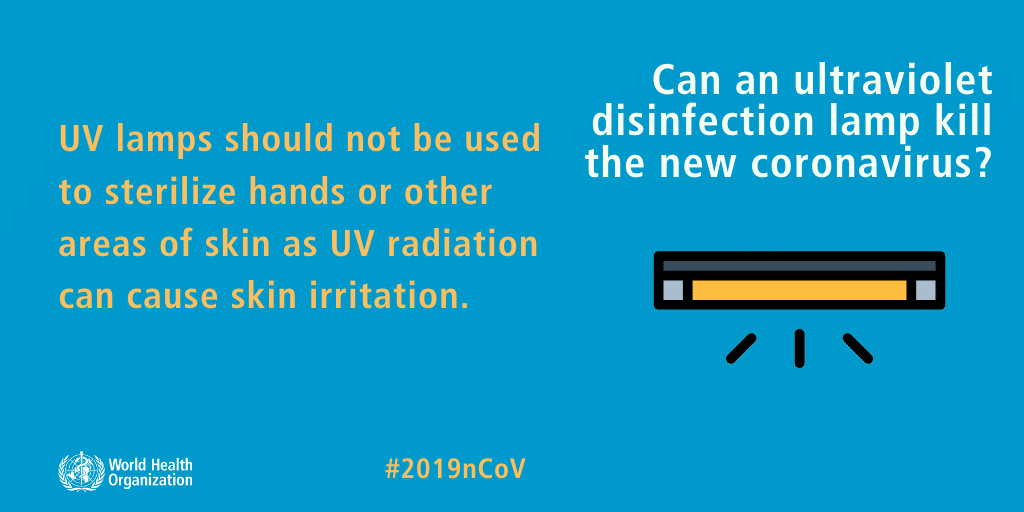Are UV light sanitizing wands and boxes effective against Covid-19?
By ConsumerLab.com
Yes, ultraviolet light in the “C” range, also known as UVC, has been shown to kill SARS-CoV-2, the virus that causes COVID-19. The big challenge with using UV-C light is being sure your UV lamp provides a large enough dose of UVC light to all the surfaces you  need to disinfect, such as a mask, phone, or an entire room, and that you are not exposed to the UVC light, as it is dangerous. UVC works fastest and most reliably on non-porous surfaces, but it may be easier and faster, as well as safer, to clean such surfaces with liquid disinfectants.
need to disinfect, such as a mask, phone, or an entire room, and that you are not exposed to the UVC light, as it is dangerous. UVC works fastest and most reliably on non-porous surfaces, but it may be easier and faster, as well as safer, to clean such surfaces with liquid disinfectants.
Many UV products marketed as “killing 99.9% of germs” may be so weak that you would need to hold them for an hour at different angles just to disinfect a mask. Masks can be more easily disinfected other ways, such as in a washing machine (for cloth masks) Read more about disinfecting N95 masks here.
If you are still interested in using UV light to help protect yourself from coronavirus, here are the things you’ll need to know.
How UV Light Kills Germs
UV radiation kills viruses and bacteria by damaging their genetic material (DNA and RNA). Of the three main types of UV light, UVC (which has a wavelength range of 200 to 280 nm) is the most effective for inactivating viruses, with the most effect wavelength being about 260 nm (Lytle, J Virol 2005).
 In order to be effective, the right “dose” of UVC must be applied. The dose is a function of the UVC intensity or “irradiance” from a specific distance from the object times the number of seconds the object is exposed. Irradiance is measured in milliwatts (mW) per square centimeter (cm2), and the dose of UVC is measured in millijoules (mJ) per square centimeter (cm2) of the object being irradiated. (In scientific terms, 1 mWs/cm2 =1 mJ/cm2).
In order to be effective, the right “dose” of UVC must be applied. The dose is a function of the UVC intensity or “irradiance” from a specific distance from the object times the number of seconds the object is exposed. Irradiance is measured in milliwatts (mW) per square centimeter (cm2), and the dose of UVC is measured in millijoules (mJ) per square centimeter (cm2) of the object being irradiated. (In scientific terms, 1 mWs/cm2 =1 mJ/cm2).
So if your UVC lamp has an irradiance of 5 mW/cm2 at a specified distance from an object, then holding the lamp at that distance from the object for 8 seconds will deliver a dose of 40 mJ/cm2, because 5 mW/cm2 multiplied by 8 seconds = 40 mWs/cm2 or 40 mJ/cm2.
A dose of 40 mJ/ cm2 is generally considered sufficient to disinfect (99.9% reduction in infectivity) a wide range of bacteria and viruses, including certain coronaviruses that infect animals (Malayeri, IUVA News 2016).
Although sunlight does not contain UVC light (because UVC light is filtered by the earth’s atmosphere), it may still be very effective against SARS-CoV-2. According to Department of Homeland Security (DHS) documents obtained by Yahoo News and noted in a White House briefing, preliminary tests by government researchers showed that simulated sunlight (equivalent to mid-day sun on a sunny day in the middle latitudes of the U.S.) reduced active SARS-CoV-2 to non-detectable levels after only 3 minutes on a non-porous surface and was similarly effective against the virus in air. Note, however, that this is not instantaneous: If you immediately inhale droplets from a cough or sneeze of an infected person, it won’t matter if you are outside on sunny day or indoors. In addition, researchers in China have reported that high temperature and UV radiation do not appear to reduce the transmission of COVID-19 (Yao, Eur Respir J 2020).
What Dose of UVC Light Kills SARS-CoV-2?
A laboratory study showed that when pieces of fabric from N95 masks and stainless steel were contaminated with a high concentration of SARS-CoV-2 and then exposed to a large hospital-type UVC lamp (containing a large array of small, LED UVC lamps), it took about one hour for the virus to become undetectable on the mask but just about 12 minutes on steel. The distance from the UVC lamp to the objects was approximately 20 inches (50 cm), at which distance the lamp had an irradiance of just 0.005 mW/cm2 (or 5 microWatts/cm2 or 5 µW/cm2) (Fischer, medRxiv, 2020 — preprint). This means that the effective dose needed to kill the virus to the point of being undetectable on the N95 fabric was 18 mJ/cm2 and, on steel, it was just 3.6 mJ/cm2. Bear in mind, however, that extra time might be needed to disinfect surfaces of larger objects and those with curved surfaces which would require different lamp angles.
 Risks of UVC light
Risks of UVC light
UVC light can damage cells in your skin and eyes just as it damages microorganisms, so you need to use it without exposing yourself. UVC light devices should never be used to attempt to disinfect hands or skin. In addition, repeated use of UVC may weaken some components of objects, such as rubber straps on masks.
Do UV products sold to consumers work?
As noted above, a UVC sanitizing or disinfecting device should have a stated wavelength between 200 to 280 nm, preferably closer to 260 nm. But just as important, it needs to disclose its irradiance in mW/cm2 (or microW/cm2, written as µW/cm2; 1,000 microW/cm2 = 1 mW/cm2) and the distance at which this can be achieved.
Many products state their wavelength, but few products provide their irradiance, which is needed to determine if they can deliver an effective dose to kill coronavirus in a reasonable amount of time. For example, there is probably no point in buying a UV wand with low irradiance if it means that you’ll have to slowly move it over an object for an hour. On the other hand, the higher the irradiance, the greater the risk to your skin and eyes when a light wand or lamp is used.
For home use, UVC “boxes” seem to make more sense than wands and open lamps. These enclosed boxes are designed to disinfect phones or other small solid and generally flat objects, like credit cards, keys, or watches. Porous or non-flat objects may cause shadowing that prevents the light from reaching parts of the object. Because the boxes are enclosed, they are safe to use, and because you can place your phone in the box and walk away, they don’t take extraordinary effort. The time needed in these boxes tends to range from about 1 to 10 minutes.
Be aware that the FDA has expressed risk with using UV light, as well as ozone gas, to clean, disinfect, or sanitize continuous positive airway pressure (CPAP) devices and accessories. The EPA advises against using ozone generators in occupied spaces to prevent COVID-19, and notes “ozone applied to indoor air does not effectively remove viruses, bacteria, mold, or other biological pollutants.” The agency also warns not to rely on air purifiers “to protect from COVID-19 in residential settings.”
__________________________
Credit: ConsumerLab.com





















